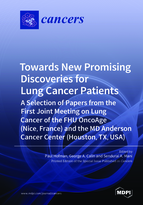Towards New Promising Discoveries for Lung Cancer Patients: A Selection of Papers from the First Joint Meeting on Lung Cancer of the FHU OncoAge (Nice, France) and the MD Anderson Cancer Center (Houston, TX, USA)
A special issue of Cancers (ISSN 2072-6694).
Deadline for manuscript submissions: closed (31 January 2019) | Viewed by 82375
Special Issue Editors
Interests: non-coding RNA; microRNA; cancer; metastasis
Special Issues, Collections and Topics in MDPI journals
Interests: predictive biomarkers in lung cancer; liquid biopsy; molecular biology; artificial intelligence
Special Issues, Collections and Topics in MDPI journals
Interests: EMT; cancer stem cells
Special Issues, Collections and Topics in MDPI journals
Special Issue Information
Dear Colleagues,
This Special Issue of Cancers will consist of selected papers from the First Annual Joint Meeting on Lung Cancer of the FHU OncoAge (www.oncoage.org, University of Côte d’Azur) and the MD Anderson Cancer Center (MDACC, University of Texas, Houston, USA), taking place in Nice (France), on 6–7 September, 2018. The FHU OncoAge was established in 2015 to bring together scientists and physicians with a shared interest in aging-related cancers, in particular, lung cancer, but also thoracic pre-neoplastic diseases, such as Chronic Obstructive Pulmonary Disease (COPD) and Idiopathic Pulmonary Fibrosis (IPF), and to provide a platform for improving research, patients health care and training for fighting age-related pathologies. In this context, a partnership with research groups, scientists and physicians between FHU OncoAge and the MD Anderson Cancer Center has been created to work in the context of age-related lung cancer and non-tumor lung diseases because both age-related chronic diseases and cancer share genomic, immune, metabolic and other biological abnormalities. Moreover, theses lung pathologies associate similar conditions inducing cellular senescence, genomic instability, oxidative stress, DNA damage, dysfunction of mitochondria, etc. Moreover, deciphering the clinical features, the biological markers, the environmental factors that are shared between chronic age-related lung pathologies and lung cancers will lead to the development of rational new clinical practices, including the validation of surrogate biomarkers of predictive response to new therapies, but also the validation of active preventive strategies. The cooperation between the FHU OncoAge and the MDACC will ensure the implementation of innovative projects. This international conference represents a major event for the medical and scientific community working on lung cancer and promises to be an inspiring meeting. Particular attention will be given to new advances in biomarker development and novel therapeutic strategies for new pathophysiological concepts.
This Special Issue will cover new and novel areas of research pertaining to lung cancer presented in this two-day conference. This issue will represent state-of-the-art and up-to-date coverage of progress dedicated to the pathology of lung cancer.
Prof. Dr. Georges A Calin
Prof. Dr. Paul Hofman
Dr. Sendurai A. Mani
Guest Editors
Manuscript Submission Information
Manuscripts should be submitted online at www.mdpi.com by registering and logging in to this website. Once you are registered, click here to go to the submission form. Manuscripts can be submitted until the deadline. All submissions that pass pre-check are peer-reviewed. Accepted papers will be published continuously in the journal (as soon as accepted) and will be listed together on the special issue website. Research articles, review articles as well as short communications are invited. For planned papers, a title and short abstract (about 100 words) can be sent to the Editorial Office for announcement on this website.
Submitted manuscripts should not have been published previously, nor be under consideration for publication elsewhere (except conference proceedings papers). All manuscripts are thoroughly refereed through a single-blind peer-review process. A guide for authors and other relevant information for submission of manuscripts is available on the Instructions for Authors page. Cancers is an international peer-reviewed open access semimonthly journal published by MDPI.
Please visit the Instructions for Authors page before submitting a manuscript. The Article Processing Charge (APC) for publication in this open access journal is 2900 CHF (Swiss Francs). Submitted papers should be well formatted and use good English. Authors may use MDPI's English editing service prior to publication or during author revisions.









